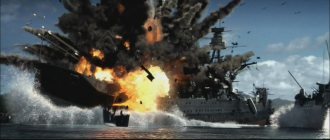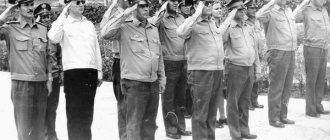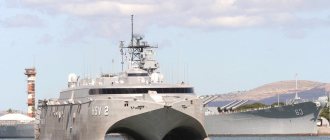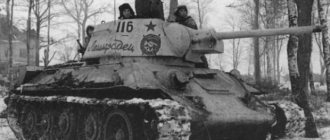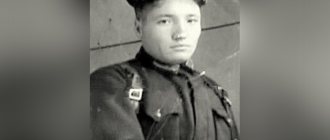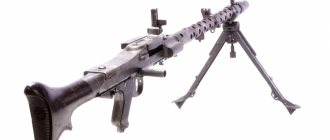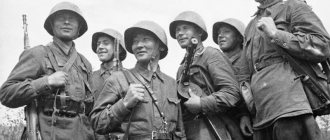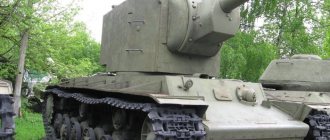If you look at where Pearl Harbor is on the world map, it’s hard to believe that this paradise of the Hawaiian Islands became a real hell one Sunday morning. On December 7, 1941, Japan attacked Pearl Harbor using the troops of Vice Admiral Chuichi Nagumo, who was assisted by midget submarines delivered to the site by submarines of the Imperial Japanese Navy. This date remains in the memory of the American people as a reminder of the horrors of a war that must not be repeated.
US Navy military exercises
The US Pacific Fleet, which was located at the Pearl Harbor military base, was considered one of the strongest fleets in the world. The military base was perfectly protected from attacks from sea and air. To test combat readiness, the Americans conducted large-scale military exercises.
In 1932, during the exercises, the American Admiral Yarmouth (commander of the “offensive” forces) behaved untypically, and instead of unleashing the full power of the naval squadron entrusted to him on the Pearl Harbor military base, he decided to attack only with the help of two fast aircraft carriers (which appeared in the fleet not so long ago). Having approached the target at a distance of 40 miles, the admiral sent 152 aircraft into battle. The attacking air forces brilliantly coped with the combat mission, conditionally destroying all aircraft at the enemy base.
Despite the complete defeat of the defenders, the US military command believed that in a real battle the aircraft carriers would be destroyed and most of the aircraft would be shot down, since the real results of the battle would differ significantly from the simulated attacks. The exercises of 1937 and 1938, as a result of which carrier-based aircraft again completely defeated the mock enemy, did not prove anything to the American military.
The thing is that battleships were considered the main force in the 1930s; attacking these powerful warships was considered a deliberately failed idea if the enemy did not have the same class of warships. All major world powers believed that the success of a war at sea depended on a single meeting of the navies of the two powers. Victory was guaranteed to be won by the side whose number of battleships exceeded its opponent. Although aircraft carriers played an important role in navies, their task was only to support battleships. The American military command was skeptical about the results of the exercises.
On November 11, 1940, a battle took place between the English aircraft carrier HMS Illustrious and the Italian battle fleet. Contrary to expectations, an attack by aircraft from a single aircraft carrier was able to destroy one Italian battleship and put two others out of action. The battle in the harbor of Taranto was considered by the American military to be luck and the result of the irresponsible attitude of the Italian military towards the battle.
A carefully thought out plan
Japanese intelligence, which worked well with the help of a residency right at the American base, constantly supplied data on the movements of American ships. With this information, Yamamoto developed a meticulously thought-out plan. Having carefully studied the experience of the British air raid on the Italian naval base in Taranto, where Japan's allies suffered heavy losses, Yamamoto borrowed many solutions. Thus, an aircraft carrier strike force advanced to the Hawaiian Islands from the Kuril Islands in complete radio silence. The group of 6 heavy aircraft carriers Akagi, Kaga, Soryu, Hiryu, Shokaku and Zuikaku was supported by impressive security. And 6 submarines were supposed to deliver midget boats to the bay to conduct torpedo attacks, and then begin patrolling.
Dropping a torpedo into the side of a battleship
Source: pinterest.ru
The main blow was delivered by carrier-based aircraft, which had 414 aircraft of three types - B5N Kate torpedo bombers, D3A Val dive bombers and the famous A6M Zero fighters. Some of the torpedo bombers performed the unconventional role of high-altitude bombers, armed with 800-kilogram armor-piercing bombs; the rest carried torpedoes, but with special wooden stabilizer devices that did not allow the torpedoes to bury themselves in the ground when dropped in a shallow bay. The dive bombers traditionally threw 250-kilogram bombs, and the Zeros used cannons and machine guns to shoot at aircraft in open parking areas and personnel. The strike was supposed to be carried out in three successive waves of aircraft.
First wave attack diagram
Source: upload.wikimedia.org
Despite all these preparations, there were several (let's call them strange) circumstances that preceded the attack, as well as the US entry into World War II. Intelligence officers at all levels, as well as friendly intelligence services, including the legendary Richard Sorge, repeatedly warned the top US leadership about the possible outbreak of hostilities, and quite accurately. On December 6, 1941, the Americans were even able to decipher a secret Japanese note in response to an American ultimatum, which effectively meant war. President Roosevelt received it at 21.30 on December 6, that is, even before the attack, but no one warned the base. Finally, about things! 50 minutes (!) before the approach, the armada of Japanese planes was detected by radar, but for some reason they were considered their own. Really, just think, more than 300 “our” planes are flying uncontrollably somewhere?! And shortly before the attack, all American aircraft carriers were relocated to the west coast of the United States and other areas - the key to future victories in the war at sea. Are there too many coincidences? Think for yourself.
Prerequisites for preparing the attack on Pearl Harbor
It is still unknown exactly why Japan decided to attack Pearl Harbor. The prerequisites for this were already evident in 1927. This year, the future Chief of Staff of the 1st Carrier Fleet, Kusaka Ryunosuke, who had just graduated from a specialized naval staff college and was at that time a captain of the second rank, began developing plans to attack the US naval base at Pearl Harbor.
Shortly after graduating from college, he was appointed to teach an aviation course to 10 important government officials, among whom was Nagano Osami (admiral and future marshal of the Imperial Japanese Navy). It was during this course that Kusaka Ryunosuke wrote a document stating that if a general battle with the American fleet did not take place, since it refused to go to the open sea, it would be necessary to urgently seize the initiative and strike at Pearl Harbor. This operation can only be carried out by aviation.
This document was published in only 30 copies and secretly distributed to the command staff. Most likely, he came to the attention of Admiral Yamamoto, after which he formed a plan in his head to attack Japan on Pearl Harbor. The results of the naval exercises forced the Japanese to take a different look at the use of aircraft carriers, and the battle in Taranto harbor convinced them of their idea.
Although Admiral Yamamoto did not approve of Japan's entry into World War II (he especially did not like the conclusion of the Tripartite Pact), as a professional military man, he did everything necessary to prepare the Japanese fleet for future hostilities. In particular, he increased the number of aircraft carriers and carried out the attack plan on Pearl Harbor.
It should be understood that Admiral Yamamoto could not have carried out the plan to attack Pearl Harbor on his own. When the situation between Japan and the United States became so tense that war became almost inevitable, Yamamoto turned to Rear Admiral Kaijiro Onishi, who commanded the 11th Air Force, for help. Kaijiro had at his disposal only Zero fighters and G3M and G4M torpedo bombers, which due to insufficient range could not participate in this operation. Onishi advised the distressed Yamamoto to contact his deputy, Minoru Genda.
Why was Genda chosen? This man, in addition to being an ace pilot (his combat fighter unit was nicknamed “Genda magicians”), had an excellent sense of tactics. In addition, he was considered the best specialist in Japan in the combat use of aircraft carriers. Genda carefully studied all the possibilities of attacking the US Pacific Fleet at the Pearl Harbor base and calculated how much material and human resources would be needed. To successfully carry out the operation, according to Genda, 6 heavy aircraft carriers were needed. It was necessary to place only the best pilots on all planes, and the operation itself had to be carried out in the strictest secrecy to ensure complete surprise.
"White Crow" among the militarists.
0
Yamamoto believed that all conflicts must be resolved at the negotiating table. After studying in Japan, he attended Harvard and then served as naval attaché at the Japanese Embassy in the United States. He took part in the second London Naval Conference in 1930 with the rank of rear admiral and in the 1934 London Naval Conference with the rank of vice admiral. While militaristic sentiments were gaining strength in Japan, Yamamoto remained a “black sheep” - he was opposed to the invasion of Manchuria, the war with China, and had an extremely negative attitude towards the conclusion of an allied pact between Nazi Germany and fascist Japan. Yamamoto's position extremely irritated supporters of the war, who began to openly threaten him.
0
“To die for the Emperor and for the Motherland is the highest honor for a military man. Flowers rise in a field where a hard, brave battle took place. And even under the threat of death, the fighter will be forever loyal to the Emperor and his land. The life and death of one person means nothing. The Empire is above all... They can destroy my body, but they will never be able to conquer my will,” Yamamoto responded to all threats. In 1939, he was appointed to the post of Commander-in-Chief of the United Fleet. This appointment was connected with the desire to remove Yamamoto from Tokyo, where the nationalists almost openly threatened him with death.
Detailed study of the combat operation
The development of the plan for the attack on Pearl Harbor was entrusted to one of the main officers of the United Fleet, Kuroshima Kameto. This officer was distinguished by his eccentricity and originality. When he “created”, he locked himself in his cabin for several days, stripped naked and sat on the table in this form, fumigating the entire room with incense. It was this strange man who developed the entire tactical plan for an attack on a US military base, taking into account all possible nuances.
The finished detailed plan was submitted to the naval general headquarters for trial, where it unexpectedly met with strong distrust and opposition. Many officers, not believing the effectiveness of aircraft carriers, believed that as a result of this operation they could all die. In addition, some were distrustful of such a large-scale operation, in which too much depended on various factors:
- The factor of surprise could fail, and the aircraft carriers would be shot on the approach to the base;
- The number of ships at the base was unknown, as was their readiness for surprise combat;
- The state of the military base's air defenses was also unknown;
- Weather conditions could also interfere with the military operation.
Admiral Yamamoto fiercely defended his plan, as he was a very gambler, ready to put everything he had on the line. When the General Staff was ready to abandon the risky operation, Admiral Yamamoto threatened to resign. Due to the fact that Admiral Yamamoto was a highly respected person, his departure would be a disaster, so the Chief of the General Naval Staff, Nagano, had no choice but to accept Yamamoto’s plan. Admiral Nagumo also doubted success. To convince him, Yamamoto stated that he was ready to personally lead troops into battle if Admiral Nagumo was afraid. In order not to “lose face,” Nagumo was forced to agree.
Why did Japan go to war with the USA?
Many still do not understand how Japan entered into a war with such a powerful power as the United States of America. This was due to several reasons:
- In 1937, Japan began a war with China, which was an economically backward country. For 3 years, Japanese troops advanced to the border of Indochina, which led to an escalation of the conflict with England and the United States;
- In 1940, Japan concluded the Tripartite Pact, which was a military alliance between three countries (Germany, Italy and Japan), which greatly influenced the deterioration of relations with the United States;
- In July 1941, when Japanese troops invaded Indochina, the United States, Holland and Great Britain imposed an embargo on oil exports to Japan.
It was this last point that was the last straw in the aggravation of relations between Japan and the United States. Japan's oil fuel reserves would last for 3 years, after which the powers with oil fields could demand any price for oil, so the Japanese command decided to seize the oil fields of Southeast Asia. Naturally, the United States did not like this decision, so the Japanese command was faced with two options for possible events:
- Capture oil fields and give battle to the American fleet on the high seas (which was quite problematic, since the forces of the American fleet were significantly superior to the Japanese fleet);
- First, defeat the enemy’s navy (through a surprise attack), and then concentrate forces on the occupation.
As you might guess, the second option turned out to be preferable.
Eliminate the admiral.
0
Among those whom the American Avengers personally hunted, number one was the commander-in-chief of the Combined Fleet of the Japanese Empire during World War II, Admiral Isoroku Yamamoto. In April 1943, American intelligence, during Operation Magic, was able to intercept and decipher information about plans regarding Admiral Yamamoto's travels. This made it possible to prepare a special operation to eliminate the Japanese commander-in-chief.
0
The go-ahead for this action was personally given by US President Roosevelt, who asked Secretary of the Navy Frank Knox to “get Yamamoto.” The operation was scheduled for April 18 and received the not-so-complicated name “Revenge.” Paradoxically, the man who became “target number one” for the Americans was one of the most vehement and consistent opponents of the war with the United States. In 1904, a graduate of the Japanese Naval Academy found himself in the thick of the Russo-Japanese War. In the Battle of Tsushima, which was victorious for the Japanese, Yamamoto was wounded, losing two fingers of his left hand. The injury did not affect his desire to continue military service, however, it may have formed a negative attitude towards military conflicts in general.
Attack on Pearl Harbor
The Japanese military unit left the Kure base between November 10 and 18, 1941. On November 22, the combat formation was in Hitokappu Bay, in the Kuril Islands area. All the necessary equipment was loaded onto the warships, including canvas covers for guns and barrels of fuel for aircraft. The people who were given a full set of winter uniforms were not forgotten either.
On November 26, the ships set off for the collection point. They all took different routes so as not to attract suspicion. It was at the gathering point that it was to be decided whether war with the United States would begin or not.
On December 1, Japan decided to start a war with the United States, which was announced to Admiral Nagumo, who commanded the entire operation, the very next day. The attack on Pearl Harbor was scheduled for December 7, which was transmitted in a coded order that read "Ascend Mount Niitaka."
In addition to aircraft carriers, about 30 different submarines took part in the combat operation, 16 of which were powerful submarines with a long range. 11 submarines each carried 1 seaplane, and 5 carried small submarines.
At 6 o'clock in the morning, combat aircraft began to take off from aircraft carriers that were 230 miles from the Hawaiian Islands. Each plane took off with precise synchronization relative to the pitching of the aircraft carriers.
Hunters and prey.
0
In February 1943, Japan was defeated at the Battle of Guadalcanal, resulting in the final loss of strategic initiative in the war. Admiral Yamamoto, realizing that after this failure the soldiers and officers were in a difficult psychological state, decided to personally inspect the troops of the South Pacific. The inspection took place in April 1943, and American intelligence officers managed to intercept information about it. The Americans learned that on the morning of April 18, Yamamoto would fly from Rabaul to Ballalae airfield, which is located on Bougainville Island in the Solomon Islands. The 339th Fighter Squadron, 347th Fighter Group, 13th Air Force, was chosen to carry out the interception, as their P-38 Lightnings had sufficient range. The American pilots were notified that they would be intercepting a "significant senior officer" but were not informed of the name of their target. The Japanese did not know that information about the commander-in-chief's movements was available to the enemy, but they feared for his safety. Admiral Yamamoto was offered to cancel the flight, but he flatly refused. Taking a seat next to the pilot in the Betty bomber, the admiral set off on a 319-mile flight right on schedule. 19 P-38s specially equipped with additional fuel tanks were to fly from Guadalcanal Island to intercept the plane carrying the admiral. In reality, 18 were able to take off, then another one returned to base due to a breakdown, and two more fell into the sea. The remainder flew at low altitude and maintained radio silence for almost the entire 430-mile flight to avoid detection.
First wave of attack on Pearl Harbor
The first combat wave, which went to bomb the US naval base, included:
- 40 Nakajima B5N2 torpedo bombers, whose torpedoes (especially for attacks in shallow water) were equipped with wooden stabilizers;
- 49 aircraft of the same type, which carried huge 800 kg bombs - deeply modernized and converted battleship shells;
- 51 aircraft of the Aichi D3A1 type (dive bomber), each of which carried a bomb weighing 250 kg;
- 43 Mitsubishi A6M2 fighters, whose task was to cover the bombers.
Perhaps the US Navy could have prepared for an attack in advance if it had promptly responded to the discovery of one of the Japanese mini-submarines. At 3:42 a.m., one of the US minesweepers noticed the periscope of a submarine that was located near the entrance to the harbor. The information was transmitted to the destroyer USS Aaron Ward, which unsuccessfully searched for her for 3 hours. At 6 o'clock this or another submarine was discovered by the Catalina flying boat, and already at 6-45 the destroyer sank it. 10 minutes after the destruction of the submarine, the destroyer transmitted a message to the duty officer, which reached him only at 7-12.
The approach of Japanese planes was noticed at 7-02 by a radar station. Privates Joseph Lockard and George Elliott, who were operators of the radar station, reported this to duty officer Joseph MacDonald, who in turn reported this information to Lieutenant K. Tyler. Knowing that B-17 bombers were about to arrive at the Pearl Harbor military base, the lieutenant reassured those on duty, saying that there was no cause for concern. The radio station, which pilots often used as a bearing, also spoke about this. That is why numerous danger signals were ignored.
The commander of the Akagi air group, Futida, in the memoirs he wrote after the war, rather inaccurately describes the signal for the attack. Although he gave it at 7:49, it was a repeated signal. The first signal, sent at 7:40, was a black flare, which was not noticed by Lieutenant Commander Itaya, leading the group of fighters. The second signal was noticed by the dive bomber commander, who immediately launched an attack.
Despite the suddenness of the attack, military musicians on the battleship USS Nevada performed the US national anthem at exactly 8:00, while bombs rained down from all sides. The musicians only lost their rhythm a little once, when one of the bombs almost hit the battleship.
Since the Japanese understood the danger enemy aircraft carriers posed, they were the main target of their attacks. But since the American aircraft carriers were not at the base during the attack, Japanese aircraft focused their attention on the battleships, since they were a fairly important target.
The most important Japanese aircraft that participated in this operation were undoubtedly torpedo bombers. 16 aircraft, due to the absence of aircraft carriers at the base, were left without a specific target and were forced to attack targets at their own discretion, which introduced a certain amount of confusion into a clearly planned attack.
The first targets to be attacked were:
- Light cruiser USS Raleigh;
- The old battleship USS Utah, which was mistaken for an aircraft carrier;
- Light cruiser Detroit.
While the attack was underway, Captain Commander Vincent Murphy discussed details of the report from the destroyer USS Aaron Ward (which sank the Japanese submarine) with Admiral Kimmel. The arriving liaison informed the commander that the attack on Pearl Harbor was not an exercise, which Vincent immediately informed the admiral about. Kimmel, in turn, conveyed this news to all parts of the navy that were at military bases and on the high seas.
Rear Admiral W. Furlong, who was on board the minelayer USS Oglala during the Japanese attack, saw enemy planes in the sky, immediately realized that this was an enemy raid and signaled all ships to leave the bay. At that moment, a Japanese torpedo passed directly under the keel of the USS Oglala, which miraculously escaped damage. It would seem that the minelayer was lucky, but the torpedo, hitting the side of the cruiser USS Helena, damaged the starboard side of the USS Oglala with an explosion, causing the ship to sink to the bottom.
The huge battleship Arizona was sunk in 10 minutes, without having time to fire a single shot. 1,177 sailors went to the bottom with him. In total, 18 ships of the American navy were disabled:
- Three battleships were sunk;
- One ran aground;
- One turned over;
- The rest received significant damage.
In addition to warships, targets for Japanese aircraft were:
- The airfield, which was located on Ford Island;
- Hickam Air Force Base;
- Wheeler Air Force Base;
- Seaplane base.
Japanese fighters began destroying American B-17 aircraft, which were nicknamed the “Flying Fortress.”
Heavy aircraft on the ground were an excellent target that was unable to fight back. After the destruction of the B-17, the American carrier-based Dontless bombers became the target of the Japanese fighters.
Japan is the army. Why was Pearl Harbor a disaster?
Exactly 75 years ago, on December 7, 1941, aircraft from Japanese aircraft carriers attacked the ships of the American Pacific Fleet located in Pearl Harbor. Due to the surprise of the attack, the ships, as well as the aircraft on the ground, suffered serious damage. American President Roosevelt called December 7 “the day of shame,” and throughout the subsequent war one of the main American slogans was “Remember Pearl Harbor!”
The operation was competently planned and carried out by the Japanese side, although the significance of this attack is traditionally exaggerated, since the Japanese never achieved the main goal - the destruction of aircraft carriers. After the war, an alternative view of the events of December 7 emerged, as it became clear that the Japanese attack could have been warned in advance. Conspiracy theories have emerged that the American leadership deliberately exposed the ships to attack (especially since mostly outdated battleships were based in the bay) in order to have an impeccable excuse for entering the war. Indeed, before this attack, such a step was not an easy matter, given the opposition of Congress and the isolationist views of a large part of society. Life found out whether the Japanese attack could be considered successful and whether the Americans really exposed themselves to the Japanese attack or whether the surprise of the attack was the result of gross mistakes by the military leadership.
Background
By 1941, the American leadership began to lean towards entering the war. At this point, the world war had been going on for almost two years. However, as during the First World War, public opinion was isolationist and did not approve of the outbreak of hostilities. Roosevelt clearly sympathized with Hitler's opponents, but did not dare to enter the war.
The Japanese planned to take advantage of the war to create an empire in the Pacific Ocean, which had no equal in Asia. The Japanese already controlled a significant part of China, but the situation was somewhat complicated by the presence of European colonies in Southeast Asia, as well as the position of the United States, which was unhappy with the Japanese attempts to dominate this region. A situation arose when it was impossible to begin the conquest of Asia without quarreling with all the great powers.
The Japanese, planning their operations, proceeded from the assumption that the Americans would in any case intervene if hostilities began against the British. There were heated debates at Japanese headquarters about whether it was necessary to disperse forces and play with fire, attacking the Americans first, and whether it would be better to concentrate all their efforts on capturing the resource-rich Asian regions, and the Americans would respond as necessary. In the end, the point of view of supporters of a preventive strike on the American fleet prevailed. This position was adhered to by Admiral Yamamoto, who believed that the Americans would enter this war in any case, so it was better to strike first in order to inflict as much damage as possible.
In this case, the Japanese made a mistake at the very beginning, because they proceeded from erroneous ideas. The Americans were physically unable to prevent the Japanese in the Pacific Ocean, since the American fleet needed to be modernized and strengthened, and a fairly significant period would have passed before the United States entered the war. Even the original American war plan provided for the emergency evacuation of the Philippines (the main American outpost in the region) in the event of an attempt to capture it.
In planning the attack, the Japanese carefully studied the attack carried out by British carrier-based aircraft against the Italian naval base at Taranto, which took place in November 1940. In terms of the ratio of the forces involved and the results achieved, this attack was unprecedented. 20 British torpedo bombers attacked Italian battleships in the harbor, sinking three ships - exactly half of all the battleships at the disposal of the Italian fleet.
The American exercises at Pearl Harbor, which simulated an air raid on ships in the harbor, were also carefully reviewed. The exercises were carried out back in the mid-30s and even then showed that an attack by an air group could be very successful.
In addition to developing an attack plan, it was necessary to choose the optimal route for the squadron to approach the American base. The entire success of the plan was based on the surprise of the attack, and this effect would have been impossible to achieve if the ships had been discovered in advance. Meanwhile, the most convenient routes for approach were either within the range of American reconnaissance aircraft or passed along busy trade routes. As a result, the most difficult route was chosen, where there was the least risk of collision with unwanted witnesses, but extremely unstable weather conditions, which significantly hampered the refueling of the ships and jeopardized the entire operation.
Much attention was paid to training the pilots who would participate in the harbor attack. On one of the Pacific islands, a detailed model of the island of Oahu was built, where Pearl Harbor, which was to be the target of the attack, was located. Beginning in September 1941, torpedo bomber pilots practiced their skills in hitting targets with torpedoes, dive bomber pilots trained to drop bombs, and fighter pilots trained to cover torpedo bombers and bombers, as well as to hit aircraft that had not yet taken off from airfields.
Relations between Japan and the United States completely deteriorated in 1941. America imposed sanctions on the Japanese, stopping selling them the oil and steel they desperately needed. The embargo on strategically important goods pushed the Japanese to intensify aggressive actions in resource-rich Southeast Asia.
Nevertheless, war with the Americans did not seem obvious to the Japanese. It was expected that the Americans would likely enter the war if Japan made further gains in Asia, but the strength of the American economy frightened the Japanese. Even though they had a detailed attack plan, the Japanese were hesitant to take any action against the United States until the end of the year. Two weeks before the attack on Pearl Harbor, American Secretary of State Cordell Hahl sent the Japanese a note in which he ultimatically demanded the withdrawal of Japanese troops from Indochina and China. This was perceived by the Japanese as an ultimatum before the war, and only after that the emperor gave the go-ahead for the attack on Pearl Harbor.
The Americans were preparing for a completely different scenario. They believed that the main target for the attack would be the Philippine Islands, where there were several American bases. From the Philippines, the Americans could terrorize Japanese sea communications to the south. At the same time, the Americans did not have the opportunity to protect the islands from a massive invasion at that time, and the initial plans provided for the evacuation of specialists and military personnel. Only through the efforts of the commander of the American and Philippine forces, General MacArthur, was the plan changed, and the Americans decided to defend the island (which they succeeded in for almost six months).
For this reason, the option of attacking Pearl Harbor was not even considered; American headquarters were absolutely sure that the Japanese were not capable of carrying out two large-scale naval operations simultaneously. As it turned out later, the Americans were cruelly mistaken.
At the end of November 1941, a strike group consisting of six aircraft carriers, 441 aircraft, two battleships, two heavy cruisers, 11 destroyers and a group of submarines, five of which carried midget submarines, left the base and moved towards the Hawaiian island of Oahu.
The squadron had orders to sink any merchant ships it encountered belonging to Britain, Holland or the United States. It was planned to seize ships of all other countries with the help of a boarding team. These actions were supposed to keep the squadron's campaign secret. If the squadron was discovered before December 6 inclusive, the attack on the American base was canceled. However, no one had to be sunk or captured, since the squadron was moving along the most unpopular route, which was rarely taken by other ships, and the campaign was kept secret until the very end.
The first to act were the submarines, which dropped five midget submarines, whose task was to penetrate the harbor and torpedo the ships when the attack began. This mission failed, the fate of two boats remained unknown, one boat landed on a reef, two more managed to penetrate into the harbor, taking advantage of someone’s criminal negligence - the anti-torpedo network was not closed. However, they were destroyed in the harbor at night, a few hours before the attack. But due to incomprehensible delays and delays, the encrypted message about the night attack reached headquarters only a few hours later, when there were only a few minutes left before the attack.
Almost an hour before the attack, a radar station in Hawaii detected Japanese planes. However, senior officers did not respond to information about unknown aircraft near the islands, probably mistaking them for American ones.
The timing of the attack was perfect. On Sunday morning, many sailors - airfield maintenance personnel, pilots, anti-aircraft gunners - were on leave. The fleet was practically defenseless.
183 Japanese aircraft took part in the first wave of the attack: 100 bombers, 40 torpedo bombers and 43 covering fighters. Their main target was battleships - the largest and, as was then considered, dangerous enemy ships.
In the first minutes after the attack, there was turmoil, many people were not at the base, most at such an early hour were raised from their beds and were now feverishly rushing around the base, trying to do at least something. Realizing that there was no question of any exercises and that the fleet was under attack by the Japanese, Rear Admiral Furlong, who was at the base, gave the order to all ships to go to sea, where they would have room to maneuver.
But it was already too late. The battleships moored next to each other were too easy a target for the Japanese pilots, who had practiced the situation many times during exercises. Dive bombers and torpedo bombers attacked the ships, while high-altitude bombers and fighters attacked the two airfields, which contained several hundred American aircraft that never had time to take off.
The most serious blow fell on the battleship Arizona, which, due to its location, turned out to be the most convenient target. The first bombs fell on it before the ship even had time to sound the alarm. As a result, it was simply riddled with hits from at least eight bombs and at least two torpedoes. Half of all Americans who died that day were among the battleship’s crew—out of one and a half thousand crew members, only 400 people survived.
Having spent their ammunition, the first wave returned to the aircraft carriers. Next came the second, slightly less numerous. In the second wave of the attack, 163 aircraft performed. This time the torpedo bombers were not involved, since the main targets were two airfields.
The American planes stood in a line, next to each other, and were completely defenseless. It would have taken so much time to prepare for the departure that the Japanese would have carried out a dozen attacks during this period. Therefore, pilots and maintenance personnel had to remove machine guns from their planes and try to scare away Japanese planes with this fire right from the ground. They, of course, could not cause serious damage with such actions. Therefore, on the day of the attack on Pearl Harbor, American aviation suffered even greater losses than the navy. Only at one of the airfields were several planes able to take off.
The attack ended two hours later with an incredible success for the Japanese forces. They sank two battleships and ran three more aground. Almost 200 aircraft were destroyed on the ground, and another hundred and fifty were very seriously damaged. 2,403 Americans died. At the same time, the losses of Japanese forces amounted to only 29 aircraft and five midget submarines. Personnel losses were also much more modest - only 64 people.
After the war, the version that the American leadership deliberately exposed part of the fleet to attack in order to persuade American public opinion towards the need for war became quite popular. In those years, most Americans adhered to isolationist views, and the United States entered World War I only after the Lusitania passenger liner was sunk by the Germans.
Several facts support this conspiracy theory:
- the absence at the time of the attack of aircraft carriers - the most formidable weapon, which was the goal of the Japanese fleet. A few days before the attack, the aircraft carriers were prudently withdrawn from the bay and sent to other places. Only battleships were attacked, essentially already outdated and meaningless ships;
- amazing complacency of Americans, bordering on criminal negligence and sabotage. The midget submarines were able to get into the harbor because someone forgot to close the anti-torpedo nets. The ships hunting for submarines that had penetrated the base reported this very late, and their encryption arrived at headquarters only in the morning, although depth charges were dropped at night;
— the data from the radar station, which detected approaching aircraft 50 minutes before the attack, were ignored. In the end, on the evening before the attack, American intelligence managed to intercept Japanese encryption, from which it became clear that on December 7 the Japanese would declare war. But even despite this, combat readiness was not declared at the main fleet base in Pearl Harbor, dismissals and vacations were not canceled, and it was simply not ready to repel the attack.
At the same time, all this can be explained not so much by the insidious intent of the leadership, who decided to expose the entire fleet to attack, but by its underestimation of the enemy. The entire American military leadership was absolutely convinced that the main goal of the Japanese would be the Philippines, without which the Japanese would not be able to operate effectively in the Pacific Ocean. And since the Americans were confident that the Japanese would not be able to carry out two powerful offensive operations involving the fleet at the same time, they firmly believed that nothing threatened the base in the Hawaiian Islands.
The American Pacific Fleet was unable to conduct serious operations for several months, which allowed the Japanese to launch a successful offensive in Asia. At first glance, it seems that the Japanese were able to achieve fantastic success, and the operation was successful. If we look at the attack on Pearl Harbor as a single battle, then it is: the Japanese achieved an undeniable and convincing victory. But if you look more globally, the operation was not very successful.
The Japanese inflicted significant damage on the battleships, but in the conditions of World War II, battleships without air support turned into an extremely vulnerable target and became essentially meaningless. Their age has passed, the era of aircraft carriers has arrived. But the Americans managed to save all their aircraft carriers, since they were not in the harbor on the day of the attack. Thus, the main striking force of the Americans was still functioning, and the task of destroying the fleet with one blow was not completed.
In addition, Japanese pilots concentrated all their forces on attacking ships and airfields, completely forgetting about oil warehouses. Pearl Harbor was one of the main bases of the Pacific Fleet, and large quantities of fuel were stored in local warehouses. The destruction of these reserves would cause even more damage to the fleet than the destruction of battleships, since ships are unable to function without fuel. At that time, the Americans had not yet transferred the economy to a military footing and were experiencing serious problems with delivering fuel to remote bases. The destruction of oil tanks at the base would create no less problems for the Americans than the need to repair battleships. By the way, the Japanese also ignored the entire infrastructure of the base and did not destroy it, which greatly helped the Americans.
Therefore, from a strategic point of view, the attack on Pearl Harbor was rather unsuccessful, although with some positive short-term effect. Instead of destroying the main base of the Pacific Fleet or making it impossible to operate for a long time, the Japanese concentrated the main attack on practically useless battleships. On the side of the Japanese was such an important factor as the surprise of the attack, and they could have used this trump card to much greater benefit for themselves.
The effect of Pearl Harbor lasted only for a few months - already six months after the attack, the surviving American aircraft carriers defeated the Japanese fleet in the Battle of Midway Atoll, sending four Japanese aircraft carriers to the bottom at once. After this, the Japanese were deprived of the ability to conduct large-scale offensive operations and lost the strategic initiative until the end of the war.
Second wave of attack on Pearl Harbor
The second wave of Japanese air attack consisted of 167 aircraft. There were no more torpedo bombers in the second wave, since the second attack was only the final stage.
It was during the second Japanese attack that American pilots were able to provide at least some resistance to Japanese aircraft. Haleiv airfield was able to organize two combat sorties consisting of 5 aircraft. These flights occurred from 8-15 to 10-00. As a result of combat missions, American pilots were able to shoot down 7 Japanese aircraft, losing only one of their own. This is an indication that US combat aircraft were significantly superior to Japanese ones.
Results of the attack on Pearl Harbor
Japan's attack on Pearl Harbor was not so much a daring raid as a necessary measure, since Japan's fuel resources were under threat. Despite all the efforts of politicians and diplomats, the oil embargo issue could not be resolved peacefully, so the command of the Japanese army was forced to launch a surprise attack on the American naval base.
This operation was planned by excellent Japanese naval specialists, who took into account every detail with Japanese scrupulousness. Japan's best aviators were selected to take part in the attack.
The main objectives that Japan set for itself when planning the attack on Pearl Harbor were:
- Completely destroy the American navy so that it does not interfere with the seizure of oil fields;
- Demoralize the spirit of the American people.
If the first task was partially completed, then the second one came true exactly the opposite. The entire war with Japan took place under the slogan “Remember Pearl Harbor.”
Since the American aircraft carriers survived, they were able to turn the tide of the Battle of Midway, after which the Japanese fleet lost 4 aircraft carriers and about 250 aircraft, forever losing the ability to operate without coastal artillery cover.
Due to the excessive caution of Admiral Nagumo, who did not strike at the base’s infrastructure, the docks and oil storage facilities remained intact. Continuing the offensive in this direction could have consolidated the success, but the Japanese command decided to transfer aircraft to southeast Asia, hastening to seize rich oil fields.
"Killers" attack.
0
Initially, the detachment of American aircraft was divided into a “killer group” and a “cover group.” It was assumed that the first of them would include four aircraft, the pilots of which must destroy Admiral Yamamoto’s plane at any cost, while the rest would engage in battle with Japanese covering fighters. The "hit team" included Lieutenant Thomas Lanphier, Lieutenant Rex Barber, Lieutenant Joe Moore and Lieutenant Jim McLanagan. However, Moore did not take off due to damage, and McLanagan returned due to problems with the fuel supply system. Lieutenants Besby Holmes and Ray Hine were urgently transferred to the “killers”, who, however, were inferior to Moore and McLanagan in skill.
0
At about 9:30 Tokyo time, American and Japanese planes met in the skies over Bougainville Island. The Japanese group included two Betty bombers (Admiral Yamamoto himself flew on one, the officers accompanying him on the other) and six Zero cover fighters. The main group of P-38s engaged the Japanese fighters in combat, while the "killers" were ordered to attack the bombers. But a technical malfunction was discovered on Holmes' plane, and he and Hine left the battle. As a result, two bombers attacked - Thomas Lanphier and Rex Barber. They completed their task - the first Betty crashed into the jungle, the second made an emergency landing on the water. The Americans did not have the opportunity to finish off the grounded plane, since it was necessary to return to base due to an extreme shortage of fuel. The Americans did not suffer any casualties directly during the attack, but upon returning to base they were intercepted by Japanese fighters. During this attack, the plane of the would-be “killer” Ray Hine was shot down and killed.
Pearl Harbor Memorial
The Pearl Harbor Memorials consist of two large complexes:
- USS Arizona Memorial;
- USS Missouri Memorial.
The Arizona Memorial is located above the site of the sinking of the battleship of the same name. Since its construction in 1962, more than a million people have visited this memorial. There is a tradition in the United States according to which every president of this country must visit this memorial at least once.
The second Missouri Memorial is located aboard the decommissioned battleship Missouri, which is a museum ship. It was on this warship that the Japanese surrender was signed in 1945.
The attack on the Pearl Harbor military base killed approximately 2,500 people. This operation did not bring Japan a complete victory over the American navy, but showed the superiority of aircraft carriers over battleships.
Award posthumously.
0
Isoroku Yamamato's grave in Tokyo.
There were three survivors in the Betty bomber that landed on the water. One of them turned out to be Vice Admiral Matome Ugaki, who would become a propagandist of the “kamikaze war.” In August 1945, the admiral himself became a suicide pilot, dying during an attack on American ships in the Okinawa area. The plane carrying Admiral Yamamoto crashed into the jungle. A rescue party led by Army engineer Lieutenant Hamasuna reached the crash site the next day. None of those who flew in this bomber survived. Admiral Yamamoto's body was found under a tree, strapped to his seat. The hand of the deceased clutched the hilt of a katana - the admiral died, as befits a true warrior, with a weapon in his hands. An examination showed that Yamamoto died before he fell to the ground, from bullet wounds received when the plane was fired upon. The admiral's remains were cremated, taken to Japan and buried with honors. Posthumously, Isoroku Yamamoto was awarded the title of "Admiral of the Fleet", as well as Japan's highest award - the Order of the Chrysanthemum.
